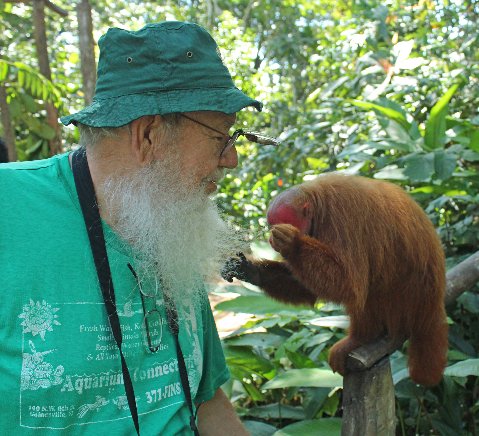Two subspecies of bark anoles,
Anolis distichus, once were identifiable in south Florida. These were the brown to gray Florida bark anole,
A. d. floridana, and the green bark anole,
A. d. dominicensis.

Wherever and whenever the two came together, they readily interbred until the characteristics of the bark anoles in Florida were so muddled that in most cases the subspecies were no longer readily identifiable. The resulting intergrades were (and are) most like the Florida subspecies with an occasional individual being a pasty greenish-gray.
Then in August 2014, a friend posted some pictures of bark anoles he recently found and his comments regarding their color changing abilities were of interest. He said that most in this small population were on mossy barked trees and although typically dark colored, when feeding on the small ants of which their diet largely consists, a few temporarily assumed a decided green coloration.
I asked for and received 2 males that he collected when they were at their greenest (these were returned and released back into the colony), but in the week that I had them - skewed by capture and captivity - this is what I learned:
More than 99% of the time the lizards were dark brown. In fact, as far as I know, one never assumed green of any shade. But on one night, and only on that night, while sleeping, one of the bark anoles did assume a green color.
At dusk that night it was dark brown.
At midnight it was still dark brown.
At 2:00AM it was light brown.
At 2:30AM it was bright green.
At 2:38AM, after I took a couple of pictures, disturbing the lizard only with the flash, it was again a very dark brown.
To the best of my knowledge it never again, while captive, assumed the green color.
If the color is this fleeting in the wild, it is no wonder we don't see many green colored bark anoles in south Florida.
I hate the picture in a cage, but it's a lot better than having no record at all. Now it's time to head for Miami and try for photos of the lizards in situ.
More photos below...
This bark anole began turning green at 2:00AM

The same bark anole at 2:30AM. The bright green coloration was retained for just a few minutes.

 Author, photographer, and columnist Richard Bartlett is one of the most prolific writers on herpetological subjects in the 20th century. With hundreds of books and articles to their credit, Richard and his wife Pat have spent over four decades documenting reptiles both in the field and in captivity. For a list of their current titles, please visit their page in our bookstore. Author, photographer, and columnist Richard Bartlett is one of the most prolific writers on herpetological subjects in the 20th century. With hundreds of books and articles to their credit, Richard and his wife Pat have spent over four decades documenting reptiles both in the field and in captivity. For a list of their current titles, please visit their page in our bookstore. |




To prevent automated Bots from commentspamming, please enter the string you see in the image below in the appropriate input box. Your comment will only be submitted if the strings match. Please ensure that your browser supports and accepts cookies, or your comment cannot be verified correctly.